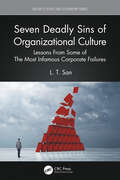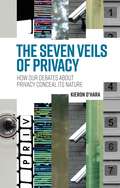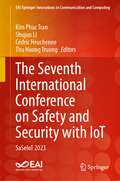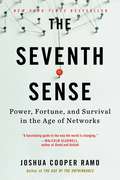- Table View
- List View
Set Up and Manage Your Virtual Private Server: Making System Administration Accessible to Professionals
by Jon WestfallThe need for every professional to have a solid presence on the Internet is more important than ever before. Having a presence beyond an email account, such as a custom web page or web application, usually requires a clumsy assortment of outside services or hiring a dedicated administrator. Thus it is more sensible for the average professional to become adept at managing their own private server. In Set Up and Manage Your Virtual Private Server, author Jon Westfall expertly designs interesting, understandable lessons for professionals such as teachers, doctors, lawyers, and more to deploy their own virtual private server. He walks you through choosing the right service and customizing it for your specific business or personal needs, and does this with great ease while instilling invaluable knowledge. Basics such as setting up users, managing security and firewalls, installing and updating software, and troubleshooting by reviewing log files, backing up data, and so much more. Set Up and Manage Your Virtual Private Server equips you with the power of knowledge to set your web presence apart from the rest. You now have complete control over your virtual brand that is your own—separate from any employer or affiliate. Your career mobility is in your hands with the ability to run your own private server at your fingertips. The digital era centers this technical literacy and independence as a critical skillset.What You Will LearnUnderstand basic server terminology and the way servers operate and are networked togetherSee how software is used on a server and its role (for example, Linux, Apache, MySQL, PHP, and so on)Get comfortable with the basic command-line operation of a virtual private server to set up users, manage security and firewalls, install software, update software, and troubleshoot by reviewing log filesStore and back up important informationIdentify, analyze, and deploy open-source software products that can enhance productivityWho This Book Is ForNon-tech professionals, individuals who have an established professional career, looking to understand more about how to set up and manage a private server.
Sets, Logic and Maths for Computing (Undergraduate Topics in Computer Science)
by David MakinsonThe first part of this preface is for the student; the second for the instructor. But whoever you are, welcome to both parts. For the Student You have finished secondary school, and are about to begin at a university or technical college. You want to study computing. The course includes some mathematics { and that was not necessarily your favourite subject. But there is no escape: some finite mathematics is a required part of the first year curriculum. That is where this book comes in. Its purpose is to provide the basics { the essentials that you need to know to understand the mathematical language that is used in computer and information science. It does not contain all the mathematics that you will need to look at through the several years of your undergraduate career. There are other very good, massive volumes that do that. At some stage you will probably find it useful to get one and keep it on your shelf for reference. But experience has convinced this author that no matter how good the compendia are, beginning students tend to feel intimidated, lost, and unclear about what parts to focus on. This short book, on the other hand, offers just the basics which you need to know from the beginning, and on which you can build further when needed.
Sets, Logic and Maths for Computing (Undergraduate Topics in Computer Science)
by David MakinsonThis easy-to-understand textbook introduces the mathematical language and problem-solving tools essential to anyone wishing to enter the world of computer and information sciences. Specifically designed for the student who is intimidated by mathematics, the book offers a concise treatment in an engaging style.The thoroughly revised third edition features a new chapter on relevance-sensitivity in logical reasoning and many additional explanations on points that students find puzzling, including the rationale for various shorthand ways of speaking and ‘abuses of language’ that are convenient but can give rise to misunderstandings. Solutions are now also provided for all exercises.Topics and features: presents an intuitive approach, emphasizing how finite mathematics supplies a valuable language for thinking about computation; discusses sets and the mathematical objects built with them, such as relations and functions, as well as recursion and induction; introduces core topics of mathematics, including combinatorics and finite probability, along with the structures known as trees; examines propositional and quantificational logic, how to build complex proofs from simple ones, and how to ensure relevance in logic; addresses questions that students find puzzling but may have difficulty articulating, through entertaining conversations between Alice and the Mad Hatter; provides an extensive set of solved exercises throughout the text.This clearly-written textbook offers invaluable guidance to students beginning an undergraduate degree in computer science. The coverage is also suitable for courses on formal methods offered to those studying mathematics, philosophy, linguistics, economics, and political science. Assuming only minimal mathematical background, it is ideal for both the classroom and independent study.
Sets, Logic and Maths for Computing (Undergraduate Topics in Computer Science)
by David MakinsonThis easy-to-follow textbook introduces the mathematical language, knowledge and problem-solving skills that undergraduates need to study computing. The language is in part qualitative, with concepts such as set, relation, function and recursion/induction; but it is also partly quantitative, with principles of counting and finite probability. Entwined with both are the fundamental notions of logic and their use for representation and proof. Features: teaches finite math as a language for thinking, as much as knowledge and skills to be acquired; uses an intuitive approach with a focus on examples for all general concepts; brings out the interplay between the qualitative and the quantitative in all areas covered, particularly in the treatment of recursion and induction; balances carefully the abstract and concrete, principles and proofs, specific facts and general perspectives; includes highlight boxes that raise common queries and clear confusions; provides numerous exercises, with selected solutions.
Setting the PACE in Product Development
by Michael E. McGrathSetting the PACE in Product Development describes how to effectively manage the key ingredients of successful product development: time, quality, talent and resources. This revised edition of Product Development provides essential insight as to how to efficiently organize people, resources and processes to dramatically improve financial results, strategic positions, internal morale and customer satisfaction. The PACE techniques integrate vital company-wide functions, engaging the entire company and focusing its collective energy on strategically and financially important goals.
Setting the PACE in Product Development
by Michael E. McGrathSetting the PACE in Product Development describes how to effectively manage the key ingredients of successful product development: time, quality, talent and resources. This revised edition of Product Development provides essential insight as to how to efficiently organize people, resources and processes to dramatically improve financial results, strategic positions, internal morale and customer satisfaction. The PACE techniques integrate vital company-wide functions, engaging the entire company and focusing its collective energy on strategically and financially important goals.
Setting up LAMP: Getting Linux, Apache, MySQL, and PHP Working Together
by Eric Rosebrock Eric FilsonYou could think of Setting Up LAMP as four books in one, but it's actually something much more valuable: a single volume that presents the open-source technologies known collectively as LAMP—Linux, Apache, MySQL, and PHP—as tightly dovetailed components of today's most affordable and effective platform for building dynamic web-based applications. Each technology has uses outside of this context, of course, but within it they form something greater than the sum of their parts. This book shows you how to take full advantage of this power, walking you through all the steps required to lay your Linux foundation, install and configure your Apache web server, and then begin using PHP to access content stored in MySQL. Here are a few of the specific topics you'll find covered inside: Installing and configuring qmail with support for IMAP, POP3, SMTP, virtual domains, spam filtering, and antivirus Managing system users and groups Configuring your network Creating a custom firewall script using IP tables Recognizing when a system is in distress Handling MySQL database replication Configuring virtual domains Writing a basic PHP script that integrates with MySQL If you're new to all of this, you'll quickly get to where you need to be to start developing and deploying the higher-level pieces of your web application. Even if you have experience with one or all of these technologies, this book—including its quick-start installation appendix—is a resource you'll want close by whenever you're setting up or fine-tuning your LAMP system.
Seven Deadliest Microsoft Attacks
by Rob Kraus Naomi Alpern Brian Barber Mike BorkinSeven Deadliest Microsoft Attacks explores some of the deadliest attacks made against Microsoft software and networks and how these attacks can impact the confidentiality, integrity, and availability of the most closely guarded company secrets. If you need to keep up with the latest hacks, attacks, and exploits effecting Microsoft products, this book is for you. It pinpoints the most dangerous hacks and exploits specific to Microsoft applications, laying out the anatomy of these attacks including how to make your system more secure. You will discover the best ways to defend against these vicious hacks with step-by-step instruction and learn techniques to make your computer and network impenetrable.The book consists of seven chapters that cover the seven deadliest attacks against Microsoft software and networks: attacks against Windows passwords; escalation attacks; stored procedure attacks; mail service attacks; client-side ActiveX and macro attacks; Web service attacks; and multi-tier attacks. Each chapter provides an overview of a single Microsoft software product, how it is used, and some of the core functionality behind the software. Furthermore, each chapter explores the anatomy of attacks against the software, the dangers of an attack, and possible defenses to help prevent the attacks described in the scenarios.This book will be a valuable resource for those responsible for oversight of network security for either small or large organizations. It will also benefit those interested in learning the details behind attacks against Microsoft infrastructure, products, and services; and how to defend against them. Network administrators and integrators will find value in learning how attacks can be executed, and transfer knowledge gained from this book into improving existing deployment and integration practices. - Windows Operating System-Password Attacks - Active Directory-Escalation of Privilege - SQL Server-Stored Procedure Attacks - Exchange Server-Mail Service Attacks - Office-Macros and ActiveX - Internet Information Serives(IIS)-Web Serive Attacks - SharePoint-Multi-tier Attacks
Seven Deadliest Network Attacks
by Stacy Prowell Rob Kraus Mike BorkinSeven Deadliest Network Attacks identifies seven classes of network attacks and discusses how the attack works, including tools to accomplish the attack, the risks of the attack, and how to defend against the attack. This book pinpoints the most dangerous hacks and exploits specific to networks, laying out the anatomy of these attacks including how to make your system more secure. You will discover the best ways to defend against these vicious hacks with step-by-step instruction and learn techniques to make your computer and network impenetrable. The book consists of seven chapters that deal with the following attacks: denial of service; war dialing; penetration testing; protocol tunneling; spanning tree attacks; man-in-the-middle; and password replay. These attacks are not mutually exclusive and were chosen because they help illustrate different aspects of network security. The principles on which they rely are unlikely to vanish any time soon, and they allow for the possibility of gaining something of interest to the attacker, from money to high-value data. This book is intended to provide practical, usable information. However, the world of network security is evolving very rapidly, and the attack that works today may (hopefully) not work tomorrow. It is more important, then, to understand the principles on which the attacks and exploits are based in order to properly plan either a network attack or a network defense. Seven Deadliest Network Attacks will appeal to information security professionals of all levels, network admins, and recreational hackers. - Knowledge is power, find out about the most dominant attacks currently waging war on computers and networks globally - Discover the best ways to defend against these vicious attacks; step-by-step instruction shows you how - Institute countermeasures, don't be caught defenseless again, and learn techniques to make your computer and network impenetrable
Seven Deadliest Social Network Attacks
by Carl Timm Richard PerezSeven Deadliest Social Network Attacks describes the seven deadliest social networking attacks and how to defend against them. This book pinpoints the most dangerous hacks and exploits specific to social networks like Facebook, Twitter, and MySpace, and provides a comprehensive view into how such attacks have impacted the livelihood and lives of adults and children. It lays out the anatomy of these attacks, including how to make your system more secure. You will discover the best ways to defend against these vicious hacks with step-by-step instruction and learn techniques to make your computer and network impenetrable. The book is separated into seven chapters, with each focusing on a specific type of attack that has been furthered with social networking tools and devices. These are: social networking infrastructure attacks; malware attacks; phishing attacks; Evil Twin Attacks; identity theft; cyberbullying; and physical threat. Each chapter takes readers through a detailed overview of a particular attack to demonstrate how it was used, what was accomplished as a result, and the ensuing consequences. In addition to analyzing the anatomy of the attacks, the book offers insights into how to develop mitigation strategies, including forecasts of where these types of attacks are heading. This book can serve as a reference guide to anyone who is or will be involved in oversight roles within the information security field. It will also benefit those involved or interested in providing defense mechanisms surrounding social media as well as information security professionals at all levels, those in the teaching profession, and recreational hackers. - Knowledge is power, find out about the most dominant attacks currently waging war on computers and networks globally - Discover the best ways to defend against these vicious attacks; step-by-step instruction shows you how - Institute countermeasures, don't be caught defenseless again, and learn techniques to make your computer and network impenetrable
Seven Deadliest Unified Communications Attacks
by Dan YorkSeven Deadliest Unified Communications Attacks provides a comprehensive coverage of the seven most dangerous hacks and exploits specific to Unified Communications (UC) and lays out the anatomy of these attacks including how to make your system more secure. You will discover the best ways to defend against these vicious hacks with step-by-step instruction and learn techniques to make your computer and network impenetrable. The book describes the intersection of the various communication technologies that make up UC, including Voice over IP (VoIP), instant message (IM), and other collaboration technologies. There are seven chapters that focus on the following: attacks against the UC ecosystem and UC endpoints; eavesdropping and modification attacks; control channel attacks; attacks on Session Initiation Protocol (SIP) trunks and public switched telephone network (PSTN) interconnection; attacks on identity; and attacks against distributed systems. Each chapter begins with an introduction to the threat along with some examples of the problem. This is followed by discussions of the anatomy, dangers, and future outlook of the threat as well as specific strategies on how to defend systems against the threat. The discussions of each threat are also organized around the themes of confidentiality, integrity, and availability. This book will be of interest to information security professionals of all levels as well as recreational hackers.Knowledge is power, find out about the most dominant attacks currently waging war on computers and networks globallyDiscover the best ways to defend against these vicious attacks; step-by-step instruction shows you howInstitute countermeasures, don’t be caught defenseless again, and learn techniques to make your computer and network impenetrable
Seven Deadliest USB Attacks
by Brian Anderson Barbara AndersonSeven Deadliest USB Attacks provides a comprehensive view of the most serious types of Universal Serial Bus (USB) attacks. While the book focuses on Windows systems, Mac, Linux, and UNIX systems are equally susceptible to similar attacks. If you need to keep up with the latest hacks, attacks, and exploits effecting USB technology, then this book is for you. This book pinpoints the most dangerous hacks and exploits specific to USB, laying out the anatomy of these attacks including how to make your system more secure. You will discover the best ways to defend against these vicious hacks with step-by-step instruction and learn techniques to make your computer and network impenetrable. The attacks outlined in this book are intended for individuals with moderate Microsoft Windows proficiency. The book provides the tools, tricks, and detailed instructions necessary to reconstruct and mitigate these activities while peering into the risks and future aspects surrounding the respective technologies. There are seven chapters that cover the following: USB Hacksaw; the USB Switchblade; viruses and malicious codes; USB-based heap overflow; the evolution of forensics in computer security; pod slurping; and the human element of security, including the risks, rewards, and controversy surrounding social-engineering engagements. This book was written to target a vast audience including students, technical staff, business leaders, or anyone seeking to understand fully the removable-media risk for Windows systems. It will be a valuable resource for information security professionals of all levels, as well as web application developers and recreational hackers. - Knowledge is power, find out about the most dominant attacks currently waging war on computers and networks globally - Discover the best ways to defend against these vicious attacks; step-by-step instruction shows you how - Institute countermeasures, don't be caught defenseless again, and learn techniques to make your computer and network impenetrable
Seven Deadliest Web Application Attacks
by Mike ShemaSeven Deadliest Web Application Attacks highlights the vagaries of web security by discussing the seven deadliest vulnerabilities exploited by attackers. This book pinpoints the most dangerous hacks and exploits specific to web applications, laying out the anatomy of these attacks including how to make your system more secure. You will discover the best ways to defend against these vicious hacks with step-by-step instruction and learn techniques to make your computer and network impenetrable. Each chapter presents examples of different attacks conducted against web sites. The methodology behind the attack is explored, showing its potential impact. The chapter then moves on to address possible countermeasures for different aspects of the attack. The book consists of seven chapters that cover the following: the most pervasive and easily exploited vulnerabilities in web sites and web browsers; Structured Query Language (SQL) injection attacks; mistakes of server administrators that expose the web site to attack; brute force attacks; and logic attacks. The ways in which malicious software malware has been growing as a threat on the Web are also considered. This book is intended for information security professionals of all levels, as well as web application developers and recreational hackers. - Knowledge is power, find out about the most dominant attacks currently waging war on computers and networks globally - Discover the best ways to defend against these vicious attacks; step-by-step instruction shows you how - Institute countermeasures, don't be caught defenseless again, and learn techniques to make your computer and network impenetrable
Seven Deadliest Wireless Technologies Attacks
by Brad HainesSeven Deadliest Wireless Technologies Attacks provides a comprehensive view of the seven different attacks against popular wireless protocols and systems. This book pinpoints the most dangerous hacks and exploits specific to wireless technologies, laying out the anatomy of these attacks, including how to make your system more secure. You will discover the best ways to defend against these vicious hacks with step-by-step instruction and learn techniques to make your computer and network impenetrable. Each chapter includes an example real attack scenario, an analysis of the attack, and methods for mitigating the attack. Common themes will emerge throughout the book, but each wireless technology has its own unique quirks that make it useful to attackers in different ways, making understanding all of them important to overall security as rarely is just one wireless technology in use at a home or office. The book contains seven chapters that cover the following: infrastructure attacks, client attacks, Bluetooth attacks, RFID attacks; and attacks on analog wireless devices, cell phones, PDAs, and other hybrid devices. A chapter deals with the problem of bad encryption. It demonstrates how something that was supposed to protect communications can end up providing less security than advertised. This book is intended for information security professionals of all levels, as well as wireless device developers and recreational hackers. Attacks detailed in this book include: - 802.11 Wireless—Infrastructure Attacks - 802.11 Wireless—Client Attacks - Bluetooth Attacks - RFID Attacks - Analog Wireless Device Attacks - Bad Encryption - Attacks on Cell Phones, PDAs and Other Hybrid Devices
Seven Deadly Sins of Organizational Culture: Lessons From Some of The Most Infamous Corporate Failures (Security, Audit and Leadership Series)
by L. T. SanThis book is about the primary symptoms present in a dysfunctional culture that could have devastating outcomes for any organization. The book outlines each of the seven sins in each chapter. Each of the first seven chapters (Chapters 1–7) starts with a famous quote related to each of the sins and then immediately recounts stories ripped from the headlines describing well-known corporate failures but with a personal touch from former employees who experienced those stories from inside the company. (The sources for these stories are all cited in their Bibliographies.) The seven sins of organizational culture are linked with seven different corporate scandals that serve as a "lesson learned" as well as seven stories of organizations that have been successful with each respective organizational attribute as follows: Flawed Mission and Misaligned Values uses WorldCom as the lesson learned and Patagonia as the success case. Flawed Incentives uses Wells Fargo as the lesson learned and Bridgeport Financial as the success case. Lack of Accountability uses HSBC as the lesson learned and McDonald’s as the success case. Ineffective Talent Management uses Enron as the lesson learned and Southwest Airlines as the success case. Lack of Transparency uses Theranos as the lesson learned and Zappos as the success case. Ineffective Risk Management uses the 2008 mortgage industry collapse as the lesson learned and Michael Burry as the success case. Ineffective Leadership summarizes all of the foregoing sins as failures of Leadership. In each chapter and for each organizational sin, the author offers seven attributes of a healthy culture to counter the cultural dysfunction. The seven healthy attributes for each of the seven sins are all original content. In Chapter 8, the author offers an approach for assessing an organization’s culture by providing seven ways to measure the different drivers of organizational culture. The ideas for how to measure corporate culture is original content, with some references to existing frameworks (all cited in the Bibliography.) Finally, in Chapter 9, the author offers a step-by-step outline for transforming the culture. The chapter starts with a story about how Korean Air suffered multiple crashes due to their corporate culture but were able to successfully transform their culture. (The source for the Korean Air story is cited in the Bibliography.) There are seven appendices, most of which are by the author except for the maturity of risk management, which references an OECD (government entity) risk management maturity framework.
Seven Deadly Sins of Organizational Culture: Lessons From Some of The Most Infamous Corporate Failures (Security, Audit and Leadership Series)
by L. T. SanThis book is about the primary symptoms present in a dysfunctional culture that could have devastating outcomes for any organization. The book outlines each of the seven sins in each chapter. Each of the first seven chapters (Chapters 1–7) starts with a famous quote related to each of the sins and then immediately recounts stories ripped from the headlines describing well-known corporate failures but with a personal touch from former employees who experienced those stories from inside the company. (The sources for these stories are all cited in their Bibliographies.) The seven sins of organizational culture are linked with seven different corporate scandals that serve as a "lesson learned" as well as seven stories of organizations that have been successful with each respective organizational attribute as follows: Flawed Mission and Misaligned Values uses WorldCom as the lesson learned and Patagonia as the success case. Flawed Incentives uses Wells Fargo as the lesson learned and Bridgeport Financial as the success case. Lack of Accountability uses HSBC as the lesson learned and McDonald’s as the success case. Ineffective Talent Management uses Enron as the lesson learned and Southwest Airlines as the success case. Lack of Transparency uses Theranos as the lesson learned and Zappos as the success case. Ineffective Risk Management uses the 2008 mortgage industry collapse as the lesson learned and Michael Burry as the success case. Ineffective Leadership summarizes all of the foregoing sins as failures of Leadership. In each chapter and for each organizational sin, the author offers seven attributes of a healthy culture to counter the cultural dysfunction. The seven healthy attributes for each of the seven sins are all original content. In Chapter 8, the author offers an approach for assessing an organization’s culture by providing seven ways to measure the different drivers of organizational culture. The ideas for how to measure corporate culture is original content, with some references to existing frameworks (all cited in the Bibliography.) Finally, in Chapter 9, the author offers a step-by-step outline for transforming the culture. The chapter starts with a story about how Korean Air suffered multiple crashes due to their corporate culture but were able to successfully transform their culture. (The source for the Korean Air story is cited in the Bibliography.) There are seven appendices, most of which are by the author except for the maturity of risk management, which references an OECD (government entity) risk management maturity framework.
Seven NoSQL Databases in a Week
by Aaron Ploetz Devram Kandhare Sudarshan Kadambi Xun Brian WuA beginner's guide to get you up and running with Cassandra, DynamoDB, HBase, InfluxDB, MongoDB, Neo4j, and RedisAbout This BookCovers the basics of 7 NoSQL databases and how they are used in the enterprisesQuick introduction to MongoDB, DynamoDB, Redis, Cassandra, Neo4j, InfluxDB, and HbaseIncludes effective techniques for database querying and managementWho This Book Is ForIf you are a budding DBA or a developer who wants to get started with the fundamentals of NoSQL databases, this book is for you. Relational DBAs who want to get insights into the various offerings of popular NoSQL databases will also find this book to be very useful.What You Will LearnUnderstand how MongoDB provides high-performance, high-availability, and automatic scalingInteract with your Neo4j instances via database queries, Python scripts, and Java application codeGet familiar with common querying and programming methods to interact with RedisStudy the different types of problems Cassandra can solveWork with HBase components to support common operations such as creating tables and reading/writing dataDiscover data models and work with CRUD operations using DynamoDBDiscover what makes InfluxDB a great choice for working with time-series dataIn DetailThis is the golden age of open source NoSQL databases. With enterprises having to work with large amounts of unstructured data and moving away from expensive monolithic architecture, the adoption of NoSQL databases is rapidly increasing. Being familiar with the popular NoSQL databases and knowing how to use them is a must for budding DBAs and developers.This book introduces you to the different types of NoSQL databases and gets you started with seven of the most popular NoSQL databases used by enterprises today. We start off with a brief overview of what NoSQL databases are, followed by an explanation of why and when to use them. The book then covers the seven most popular databases in each of these categories: MongoDB, Amazon DynamoDB, Redis, HBase, Cassandra, InfluxDB, and Neo4j. The book doesn't go into too much detail about each database but teaches you enough to get started with them.By the end of this book, you will have a thorough understanding of the different NoSQL databases and their functionalities, empowering you to select and use the right database according to your needs.Style and approachThis book is a quick-start guide with short and simple introductory content on the seven popular databases.
The seven veils of privacy: How our debates about privacy conceal its nature
by Kieron O'HaraPrivacy is one of the most contested concepts of our time. This book sets out a rigorous and comprehensive framework for understanding debates about privacy and our rights to it. Much of the conflict around privacy comes from a failure to recognise divergent perspectives. Some people argue about human rights, some about social conventions, others about individual preferences and still others about information and data processing. As a result, ‘privacy’ has become the focus of competing definitions, leading some to denounce the ‘disarray’ in the field. But as this book shows, disagreements about the role and value of privacy obscure a large amount of agreement on the topic. Privacy is not a technical term of law, cybersecurity or sociology, but a word in common use that adequately expresses a few simple and related ideas.
The seven veils of privacy: How our debates about privacy conceal its nature
by Kieron O'HaraPrivacy is one of the most contested concepts of our time. This book sets out a rigorous and comprehensive framework for understanding debates about privacy and our rights to it. Much of the conflict around privacy comes from a failure to recognise divergent perspectives. Some people argue about human rights, some about social conventions, others about individual preferences and still others about information and data processing. As a result, ‘privacy’ has become the focus of competing definitions, leading some to denounce the ‘disarray’ in the field. But as this book shows, disagreements about the role and value of privacy obscure a large amount of agreement on the topic. Privacy is not a technical term of law, cybersecurity or sociology, but a word in common use that adequately expresses a few simple and related ideas.
The Seventeen Provers of the World: Foreword by Dana S. Scott (Lecture Notes in Computer Science #3600)
by Freek WiedijkCommemorating the 50th anniversary of the first time a mathematical theorem was proven by a computer system, Freek Wiedijk initiated the present book in 2004 by inviting formalizations of a proof of the irrationality of the square root of two from scientists using various theorem proving systems. The 17 systems included in this volume are among the most relevant ones for the formalization of mathematics. The systems are showcased by presentation of the formalized proof and a description in the form of answers to a standard questionnaire. The 17 systems presented are HOL, Mizar, PVS, Coq, Otter/Ivy, Isabelle/Isar, Alfa/Agda, ACL2, PhoX, IMPS, Metamath, Theorema, Leog, Nuprl, Omega, B method, and Minlog.
The Seventh International Conference on Safety and Security with IoT: SaSeIoT 2023 (EAI/Springer Innovations in Communication and Computing)
by Kim Phuc Tran Shujun Li Cédric Heuchenne Thu Huong TruongThis book presents the Fifth International Conference on Safety and Security with IoT (SaSeIoT 2023), which took place Bratislava, Slovakia, October 24-26, 2023. The conference aims to explore not only IoT and its related critical applications but also IoT towards Security and Safety. The conference solicits original and inspiring research contributions from experts, researchers, designers, and practitioners in academia, industry and related fields and provides a common platform to share knowledge, experience and best practices in various domains of IoT.
The Seventh Sense: Power, Fortune, and Survival in the Age of Networks
by Joshua Cooper RamoEndless terror. Refugee waves. An unfixable global economy. Surprising election results. New billion-dollar fortunes. Miracle medical advances. What if they were all connected? What if you could understand why? The Seventh Sense is the story of what all of today's successful figures see and feel: the forces that are invisible to most of us but explain everything from explosive technological change to uneasy political ripples. The secret to power now is understanding our new age of networks. Not merely the Internet, but also webs of trade, finance, and even DNA. Based on his years of advising generals, CEOs, and politicians, Ramo takes us into the opaque heart of our world's rapidly connected systems and teaches us what the losers are not yet seeing -- and what the victors of this age already know.
Sex Ed: A Guide for Adults
by Ruby RareAll the things you should know, but don't This is an essential guide for adults.A mixture of tips and 'real life' sex stories, with advice from a professional educator.
Sex Ed: A Guide for Adults
by Ruby RareWritten by sex educator and body-positivity advocate Ruby Rare, Sex Ed is the practical and fun guide to sex that you've always wanted – but never known how to ask for.This is the information you should have been taught at school: a no-holds-barred roadmap that covers everything from how the brain is the most important sex organ and how to communicate what you want to yourself and a partner, all the way down to the messy stuff – solo sex, orgasms, touching, kissing, blow jobs, cunnilingus, anal play, lube, toys, kegels.After all, sex education shouldn't start and end with putting a condom on a banana.
Sex Robots: Social Impact and the Future of Human Relations (Philosophical Studies in Contemporary Culture #28)
by Ruiping Fan Mark J. CherryThis book provides cross-cultural ethical exploration of sex robots and their social impact. What are the implications of sex robots and related technological innovations for society and culture? How should we evaluate the significance of sexual relations with robots that look like women, men or children? Critics argue that sex robots present a clear risk to real persons and a social degradation that will increase sexual violence, objectify women, encourage pedophilia, reinforce negative body images, increase forms of sexual dysfunction, and pass on sexually transmitted disease. Proponents judge robotic sexual companionship as just another step in the exploration of human desire. They see sex robots, and similar technology, such as virtual reality pornography, as providing autonomy affirming companionship for the lonely and a relatively harmless outlet for sexual fantasies that avoids the use of human prostitutes and thus reduces sexual victimization. Some appreciate sex robots as a social evil, others as a positive good, and still others as a harmless pastime. How we come to terms with such conceptual and moral concerns will have significant implications for society and the future of human relations. This book is of great interest to researchers in bioethics, human sexual behavior, AI ethics, and philosophy of sex.





















